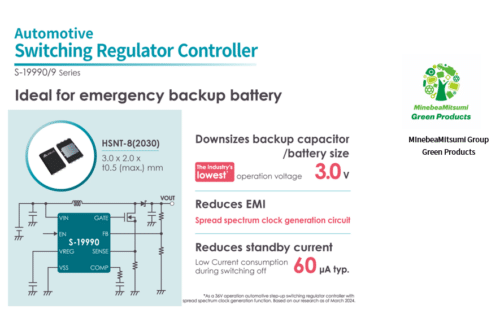The new step-up switching regulator controllers are designed to improve vehicle safety and power efficiency in critical systems.

ABLIC, a subsidiary of MinebeaMitsumi Inc., has launched the S-19990/9 Series of automotive step-up switching regulator controllers.
Electronic Control Units (ECUs) and sensors are integrated into various systems as vehicles become more electrified. Typically, ECUs rely on 12V auxiliary batteries for power. However, in the event of an impact, such as a traffic accident, power loss can cause these ECUs to malfunction. With the advancement in electrification, there is a growing emphasis on safety measures. To safeguard passenger safety, backup power supplies can be installed for ECUs in critical systems like electric door latches and E-Call, ensuring they remain operational for a particular duration, even post-accident. These backup power supplies consist of capacitors/batteries and a step-up circuit. When low-voltage capacitors/batteries are used to minimize size and costs, a step-up circuit is essential to elevate this low voltage to 12V backup power.
The switching regulator controllers are 36V step-up switching regulator controllers capable of achieving an operating voltage from a low of 3V, making them suitable for designing backup power supply step-up circuits. The series offers oscillation frequencies of 400kHz or 2.2MHz.
Moreover, these ICs are equipped with a spread spectrum clock generation circuit, which helps reduce the conduction and emission noise generated by the step-up circuit. They can also operate at a low consumption current of 60μA Typ. while switching off and maintaining response characteristics. These attributes enable the products to meet the safety requirements while further reducing the voltage of backup capacitors/batteries and achieving smaller sizes, lower costs, reduced noise, decreased standby current, and faster response times.
Additionally, the series incorporates a built-in voltage feedback resistance circuit, which cuts off the voltage feedback resistance circuit current path during sleep mode, allowing for a more significant reduction in standby current compared to the S-19990 Series, which uses an external voltage feedback resistance circuit.
For more information, click here.








Or perhaps we don’t insist that everything be electronic? To use one example provided, door latches have no reason to have electronics beyond a switch. This unnecessary complexity increases cost and reduces reliability.
I love designing and using electronics, but everything has its place. Exiting a vehicle should not require functional computer systems.
Not to miss the point of the article, though, that does look like a nice step-up converter.